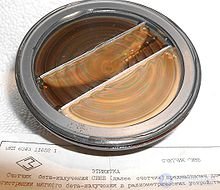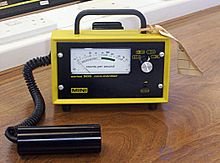Lecture


The Heiger counter, the Heiger – Muller counter is a gas-discharge instrument for automatically calculating the number of particles that have entered it in non-ionizing particles. It is a gas-filled condenser that breaks through the passage of an ionizing particle through the volume of gas. Invented in 1908 by Hans Geiger.
An additional electronic circuit provides the meter with power (as a rule, not less than 300 V), provides, if necessary, discharge suppression and counts the number of discharges through the counter.
Geiger counters are divided into non-self-extinguishing and self-extinguishing (not requiring an external discharge termination scheme).
In household dosimeters and radiometers manufactured by the USSR and Russia, meters with an operating voltage of 390 V are commonly used:
The widespread use of a Geiger-Müller counter is due to its high sensitivity, the ability to record various kinds of radiation, the relative simplicity and low cost of the installation. The counter was invented in 1908 by Geiger and improved by Muller.
A cylindrical Geiger-Muller counter consists of a metal tube or a glass tube metallized from the inside, and a thin metal thread stretched along the axis of the cylinder. The thread serves as the anode, the tube as the cathode. The tube is filled with rarefied gas, in most cases using noble gases - argon and neon. A voltage of hundreds to thousands of volts is created between the cathode and the anode, depending on the geometrical dimensions of the material of the electrodes and the gas medium inside the meter. In most cases, widely used domestic Geiger counters require 400 V.
Work counter based on impact ionization. γ-quanta emitted by a radioactive isotope, falling on the walls of the counter, knock electrons out of it. Electrons, moving in gas and colliding with gas atoms, knock electrons out of atoms and create positive ions and free electrons. The electric field between the cathode and the anode accelerates electrons to energies at which impact ionization begins. There is an avalanche of ions, leading to the multiplication of primary carriers. At a sufficiently high intensity of the field, the energy of these ions becomes sufficient to generate secondary avalanches capable of maintaining an independent discharge, with the result that the current through the counter increases sharply. By this, the Geiger counter differs from the proportional counter, where the field strength is insufficient for the occurrence of secondary avalanches, and the discharge stops after the passage of the primary avalanche. In this case, a voltage impulse is formed at the resistance R, which is fed to a recording device. In order for the counter to register the next particle that fell into it, the avalanche discharge needs to be turned off. This happens automatically. At the moment of the appearance of a current pulse on the resistance R, a large voltage drop occurs, so the voltage between the anode and the cathode decreases sharply - so that the discharge stops and the meter is ready for operation again. To accelerate the damping, special circuits can be used to forcibly reduce the voltage at the meter, which also makes it possible to reduce the anode resistance and increase the signal level. More often, however, some halogen (bromine or iodine) or an organic compound with a relatively large molecular weight (usually any alcohol) is added to the gas mixture in the meter - these molecules interact with positive ions, resulting in ions with greater mass and lower mobility. In addition, they intensively absorb the ultraviolet radiation of a discharge — these two factors lead to a quick and spontaneous quenching of the discharge, even with a small anodic resistance. Such counters are called self-extinguishing. In the case of the use of alcohol as a quenching additive, with each pulse some of its quantity is destroyed, therefore, the quenching additive is consumed and the meter has a certain (albeit rather large) resource in the number of registered particles. When it is exhausted, the counter begins to "burn" - the counting rate spontaneously increases even in the absence of irradiation, and then a continuous discharge occurs in the counter. In halogen counters, the decayed halogen molecules are again connected, therefore their resource is much higher (10 10 pulses and higher).
The counting characteristic (the dependence of the counting rate on the voltage at the meter) has a well-pronounced plateau, within which the counting rate very little depends on the voltage on the meter. The length of such a plateau reaches for low-voltage meters 80-100 V, and for high-voltage meters - several hundred volts.
The duration of the signal from the Geiger counter is relatively long (≈ 10 -4 s). It is precisely such a time that the slow positive ions that fill the space near the filament-anode after the passage of the particle and the passage of an electron avalanche go to the cathode and the sensitivity of the detector is restored.
An important characteristic of the meter is its effectiveness. Not all γ-photons trapped on the counter will give secondary electrons and will be registered, since the acts of interaction of γ-rays with matter are relatively rare, and some of the secondary electrons are absorbed in the walls of the device, not reaching the gas volume.
The efficiency of particle registration with a Geiger counter varies depending on their nature. Charged particles (for example, alpha and beta rays) almost always cause a discharge in the counter, but some of them are lost in the material of the counter walls. This is especially true for alpha particles and soft beta radiation. To register them in the counter, a thin window (2-7 microns for alpha-radiation and 10-15 for soft beta-radiation) is made from a window of mica, aluminum or beryllium foil or a polymer film. The efficiency of the counter for x-ray and gamma radiation depends on the wall thickness of the counter, their material and the energy of γ-radiation. Since γ-radiation interacts weakly with the substance, usually the efficiency of γ-counters is small and is only 1-2%. The most effective are the counters, the walls of which are made of a material with a large atomic number Z, since this increases the formation of secondary electrons. In addition, the wall of the counter must be thick enough. The wall thickness of the counter is chosen from the condition of its equality to the free path of the secondary electrons in the wall material. With a large wall thickness, secondary electrons will not pass into the working volume of the counter, and no current pulse will occur. This leads to a characteristic dependence of the count rate on gamma-quantum energy (the so-called “stiffness stroke”) with a pronounced maximum, which in most Geiger counters is located in the area of soft gamma radiation. When using Geiger counters in dosimetry equipment, a “stroke with rigidity” is partially corrected with an additional screen (for example, steel or lead), which absorbs soft gamma radiation near the maximum sensitivity and at the same time slightly increases the efficiency of recording hard gamma quanta due to generating secondary electrons and Compton radiation in the screen material. As a result, the dependence of the count rate on the dose rate is largely flattened. This screen is often made removable to allow separate determination of beta and gamma radiation. On the contrary, counters with a thin window, like that used in detectors for alpha and soft beta radiation, are used to register X-ray radiation.
Neutrons are not directly detected by gas-discharge counters. The use of helium-3 or boron as a gas medium in the composition of the wall material allows neutrons to be recorded by charged products of nuclear reactions. In addition to the low efficiency, which is highly energy-dependent, a disadvantage of the Geiger-Muller counter is that it does not allow for the identification of particles and the determination of their energy. These disadvantages are absent in scintillation counters.
When measuring weak fluxes of ionizing radiation with a Geiger counter, it is necessary to take into account its own background. Even in thick lead protection, the counting rate never becomes zero. One of the reasons for this spontaneous activity of the counter is the hard component of cosmic radiation, which penetrates without significant attenuation even through tens of centimeters of lead and consists mainly of muons. After every square centimeter, on average, about 1 muon per minute flies by the Earth’s surface, while their registration with a Geiger counter is almost 100% efficient. Another source of background is the radioactive "contamination" of the materials of the meter itself. In addition, spontaneous emission of electrons from the counter cathode makes a significant contribution to its own background.
It should be noted that for historical reasons, there is a discrepancy between the Russian and English versions of this and subsequent terms:
| Russian | English |
|---|---|
| Geiger counter | Geiger sensor |
| geiger tube | Geiger tube |
| radiometer | Geiger counter |
| dosimeter | dosimeter |
Comments
To leave a comment
Radio tubes and ion devices
Terms: Radio tubes and ion devices